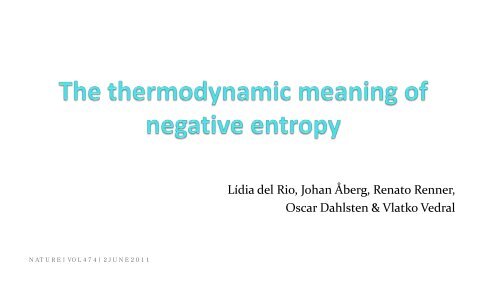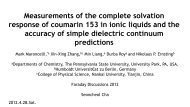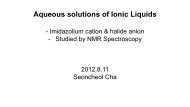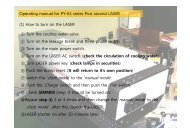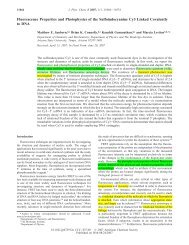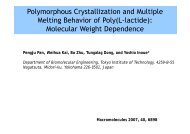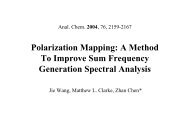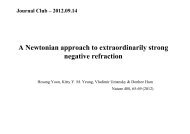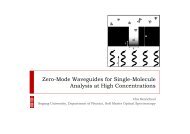The thermodynamic meaning of negative entropy
The thermodynamic meaning of negative entropy
The thermodynamic meaning of negative entropy
You also want an ePaper? Increase the reach of your titles
YUMPU automatically turns print PDFs into web optimized ePapers that Google loves.
N AT U R E | VO L 4 7 4 | 2 J U N E 2 0 1 1<br />
Lídia del Rio, Johan Å berg, Renato Renner,<br />
Oscar Dahlsten & Vlatko Vedral
Introduction<br />
Landauer’s principle states that the erasure <strong>of</strong> data stored in a system has<br />
an inherent work cost and therefore dissipates heat<br />
the more an observer knows about the system, the less it costs to erase it
‘Erasure’ <strong>of</strong> a system is defined as taking it to a pre-defined pure state, |0˃<br />
<strong>The</strong> energy dissipated to erase a system, S<br />
the von Neumann <strong>entropy</strong><br />
the Boltzmann<br />
constant
a pure<br />
state<br />
a fully<br />
mixed<br />
state<br />
Classical<br />
observers<br />
represent<br />
their<br />
information<br />
about S in a<br />
memory<br />
that consists<br />
<strong>of</strong> classical<br />
bits<br />
In equation (1) W(S) - the ‘cost <strong>of</strong> erasure’<br />
Denote (1) by W(S|C)- the ‘cost <strong>of</strong> erasure<br />
for observer C’<br />
<strong>The</strong> observer C is assumed to be classical
Quasimodo<br />
He has a memory that includes n qubits, each<br />
maximally entangled with a particle <strong>of</strong> S<br />
H(S|Q)=H(SQ)-H(Q)<br />
This work cost is optimal, under the assumption that Landauer’s principle holds<br />
for a classical observer<br />
Methods Summary
Figure 1 | Erasure in quantum computation.<br />
a unitary transformation<br />
the final state<br />
<strong>of</strong> X<br />
correlations between X and F have<br />
been destroyed<br />
highly correlated subsystems<br />
<strong>of</strong> X and F<br />
erase F while it is still<br />
partly entangled with X,<br />
using the correlations
Figure 2 | Erasure setting.<br />
(1) applying unitary<br />
operations to those systems<br />
(2) raising or lowering any<br />
energy levels <strong>of</strong> their<br />
Hamiltonian
Figure 3 | Erasure <strong>of</strong> a pure state.<br />
<strong>The</strong> work required for erasure may be <strong>negative</strong> for an observer with a quantum<br />
memory: the process results in a net gain <strong>of</strong> work (from eq. 3)<br />
<strong>The</strong> circles represent the<br />
energy eigenstates <strong>of</strong> system S<br />
A filled circle means that the system can<br />
be found in that state with certainty
Figure 4 | Erasure <strong>of</strong> a fully mixed state and work extraction.<br />
Bob has maximal uncertainty: H(S|B)=n.<br />
<strong>The</strong> work cost <strong>of</strong> this process is nkTln(2).
Quasimodo<br />
His memory contains n qubits<br />
maximally entangled with S<br />
To erase S, Quasimodo combines<br />
two elementary procedures:<br />
<strong>The</strong> erasure process<br />
used by Bob<br />
Its reverse<br />
<strong>The</strong>y call this part <strong>of</strong> his memory Q1<br />
and denote the entangled state |SQ1><br />
<strong>The</strong> rest <strong>of</strong> his memory, Q2, is correlated<br />
with a reference system, R, in state |Q2R>
Figure 5 | General erasure procedure.
Summarize<br />
the erasure can be optimized if information stored in other parts <strong>of</strong> the<br />
memory is used<br />
the results suggest that discord can quantify the difference between the<br />
respective work costs <strong>of</strong> erasure using quantum and classical memories<br />
infer that the conditional <strong>entropy</strong> H(S|Q) cannot decrease under local<br />
operations on Q, which is a fundamental result in information theory known as<br />
the data processing inequality


